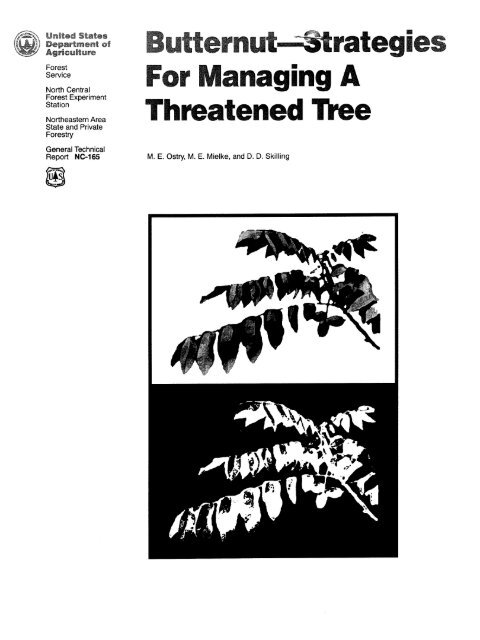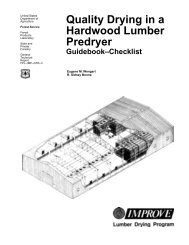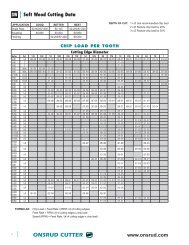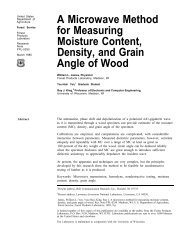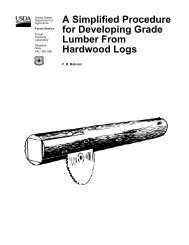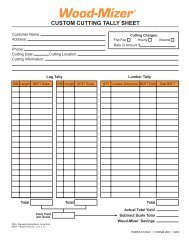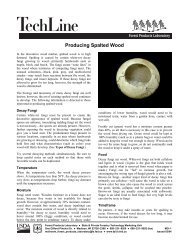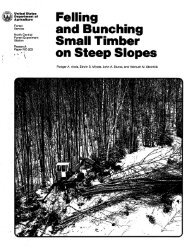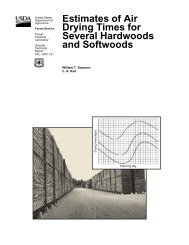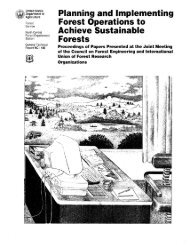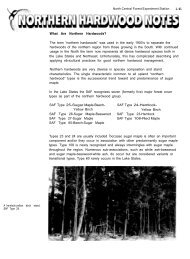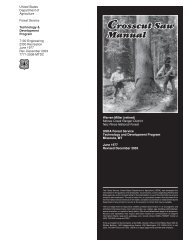Butternut - Woodweb
Butternut - Woodweb
Butternut - Woodweb
Create successful ePaper yourself
Turn your PDF publications into a flip-book with our unique Google optimized e-Paper software.
..,._1ooo°°.o° rill |es<br />
__°°°'°°°°°'°° Butte<br />
Agr_©uJtufe<br />
_o:,_<br />
North Central<br />
Forest Experiment<br />
Station Northeastern Area<br />
State and Private<br />
Forestry<br />
ut_rateg"<br />
For Managing A<br />
Threatened "free<br />
General Technical<br />
Report NC-165 M.E. Ostry, M. E. Mielke, and D. D. Skilling
<strong>Butternut</strong>--Strategies For Managing<br />
A Threatened Tree<br />
M.Eo Ostry, M.E. Mielke, and D.D. SkiUing<br />
<strong>Butternut</strong> (Juglans cinerea) is being killed<br />
throughout its range in North America (fig. 1)<br />
by Sirococcus clavigignentijuglandacearum, a<br />
fungus of unknown origin causing multiple<br />
branch and stem cankers that eventually girdle<br />
infected trees (USDA Forest Service 1993).<br />
Sprouts, if they develop, are also infected and<br />
killed usually within the first few years. The<br />
disease was first reported from Wisconsin in<br />
1967 (Renlund 1971), but it probably was<br />
present in the State for several years before<br />
then (Kuntz et aI. 1979). The fungus was<br />
described as a new species in 1979 (Nair et al.<br />
1979) and only butternut is known as its<br />
natural host, although black walnut and many<br />
other JugIans species and hybrids can be<br />
infected when wound-inoculated (Orchard et<br />
al. 1982).<br />
<strong>Butternut</strong> is valued for its wood for furniture,<br />
panel{ng, specialty products, and carving, and<br />
for its nuts. Ecologically, butternut is an<br />
important source of wildlife mast, especially in<br />
the northern portion of its range where walnut U NAI IV[ RAI_G[ 0 F B[IT1[ RNUT<br />
is not present. <strong>Butternut</strong> is not commonly<br />
found growing in great numbers anywhere in Figure 1.--Native range of butternut.<br />
its range, so there is concern to maintain a<br />
viable butternut population to preserve<br />
seldom exceeding 75 years of age. It commonly<br />
biodiversity in the eastern forests, grows<br />
rocky<br />
on rich loamy soils as well as on drier,<br />
soils of limestone origin. On deeper soils<br />
GROWING REQUIREMENTS OF BUTTERNUT it forms a taproot and wide-spreading lateral<br />
roots. <strong>Butternut</strong> never occurs in pure stands,<br />
<strong>Butternut</strong> is a small- to medium-size tree, 40- although it is occasionally abundant locally in<br />
60 feet high and 12-24 inches in diameter mixed hardwood forests (Rink 1990, Harlow et<br />
(maximum size 110 feet and 60 inches), al. 1978).<br />
M.E. Ostry is a Plant Pathologist with the <strong>Butternut</strong> is a shade intolerant species. Young<br />
Forest Insect and Disease Unit, North Central trees may withstand competition from the side,<br />
Forest Experiment Station, St. Paul, Minnesota. but will not survive shade from above. <strong>Butternut</strong><br />
must be in the overstory to thrive (Rink<br />
M.E. Mielke is a Forest Health Specialist, 1990, Harlow et al. 1978). Reproduction can<br />
Northeastern Area State & Private Forestry, St. only be sustained in stand openings or fields<br />
Paul, Minnesota. where shade cannot impede its development.<br />
The minimum size area needed to establish<br />
D.D. Skilling is a Plant Pathologist with the and promote early development of intolerant<br />
Forest Insect and Disease Unit, North Central species is about 2 to 3 times the height of the<br />
Forest Experiment Station, St. Paul, Minnesota. surrounding dominant trees. Generally,
openings smaller than 2 acres have a large butternut on National For estso Bu_i:te__°nutis<br />
proportion of their area on the edge where currently listed under Catego_ _2 on the itist of<br />
reproduction grows slowly because of shading Endangered and Threatened Plants under the<br />
from the surrounding trees (Clark and Endangered Species Act. This catego_ in-<br />
Hutchinson 1988). As intolerant trees begin to cludes species for which there is some evidence<br />
develop, room must be provided for them to of vulnerability, but not enough data to supgrow<br />
into and stay in the upper canopy. Thus, port listing at this time. Additional data on the<br />
over time, smaller openings must be enlarged, health of butternut are being collected in<br />
or thinnings made, to allow for full growth and several States to determine if it is a Threatened<br />
development of the trees, species.<br />
Seed production begins at about 20 years, and DISEASE DF_CRIFI'ION<br />
is optimum between 30-60 years of age. Good<br />
seed crops occur every 2-3 years, although Young cankers are elongated, sunken areas<br />
some seed is produced every year. Squirrels that commonly originate at leaf scars and<br />
and other rodents are aggressive consumers of buds, often with an inky black center and<br />
butternut seed, and premature seed losses due whitish margin (Nicholls et al. 1978). Peeling<br />
to insects and lack of pollination often cause the bark away reveals the brown to black<br />
low viable seed yields. Seeds usually germi- elliptical areas of killed cambium. Older<br />
nate in the spring following seedfall. Stumps branch and stem cankers are perennial, found<br />
of small diameter butternut trees and saplings in bark fissures or covered by shredded bark,<br />
are capable of sprouting (Rink 1990). and bordered by successive callus layers.<br />
Cankers commonly occur at the base of trees<br />
DISEASE DISTRIBUTION AND IMPACT and on exposed roots. Branch cankers usually<br />
occur first in the lower crown, and then stem<br />
A recent compilation of USDA Forest Service cankers develop from spores washing down<br />
Forest Inventory and Analysis forest inventory from branch cankers (Tisserat and Kuntz<br />
data show a dramatic decrease in the number 1983a). The fungus can survive and sporulate<br />
of live butternut trees throughout the United on dead trees for at least 20 months (Tisserat<br />
States in the last 10 to 15 years. For example, and Kuntz 1984).<br />
live butternut, in all size classes combined,<br />
decreased by 58 percent in Wisconsin and 84 FUNGUS DESCRIPTION<br />
percent in Michigan during this period. These<br />
data do not distinguish healthy from diseased Spores (conidia) of the fungus are dissemitrees.<br />
A recent Wisconsin Department of nated from fruit-bodies (pycnidia) by<br />
Natural Resources survey revealed that 91 rainsplash and possibly by insects. Spores are<br />
percent of the live butternut in all age classes produced throughout the growing season<br />
in Wisconsin were diseased (Cummings (Nicholls 1979, Tisserat and Kuntz 1982).<br />
Carlson 1993). Forest inventory surveys in Once airborne, they can survive and be dis-<br />
North Carolina and Virginia showed a 77 persed long distances during favorable weather<br />
percent decrease in butternut from 1966 to conditions of cool temperatures and overcast<br />
1986 (Robert Anderson, personal communica- skies (Tisserat and Kuntz 1983b).<br />
tion). An inventory in the Great Smoky Mountains<br />
National Park showed that all 77 butter- MANAGEMENT GUIDELINES<br />
nut trees remaining there were diseased (Keith<br />
Langdon, personal communication). In addi- Coalescing cankers eventually kill severely<br />
tion, many older butternut trees throughout affected trees. Such trees can be harvested<br />
the species' range are declining from causes early to salvage the quality and value of the<br />
other than the canker disease, wood, or the tree can be maintained in the<br />
stand for its wildlife value. Care needs to be<br />
The Minnesota Department of Natural Re- exercised in evaluating trees for butternut<br />
sources placed a moratorium on the harvest of canker so that trees with dead branches are<br />
healthy butternut from State land adminis- not automatically considered diseased. Antered<br />
by the Division of Forestry in August other fungus, Melanconis oblongum (perfect<br />
1992. The USDA Forest Service in March 1993 state M.juglandis), often colonizes dead butteralso<br />
placed harvest restrictions on healthy nut tissues but does not cause lethal cankers.<br />
2
One of' the re@or objectives of the following tree T_E RETENTION GUIDELINF__<br />
retention guidelines is to create stand condi- THE 70-20-50 RUlE<br />
tions that will result in the establishment of<br />
natural regeneration. Trees free of canker, or o Retain all trees with more than 70<br />
those able to overcome infections, should be percent live crown (figs. 2 and 3), and<br />
retained to reproduce. Natural regeneration less than 20 percent of the combined<br />
will probably not survive in stands that have circumference of the bole and root<br />
susceptible trees and a high incidence of the flares affected by cankers (fig. 4).<br />
disease. Resistant seedlings, when available,<br />
should be planted in these stands and else- • Retain all trees with at least 50<br />
where, percent live crown (figs. 3 and 5), and<br />
no cankers on the bole or root flares.<br />
Because butternut is an intolerant species,<br />
successful regeneration will require that * Dead butternut, and butternut of<br />
competition be controlled within the small poor vigor, may be cut.<br />
openings created by single-tree or group<br />
selection or in larger clearcuts. In some areas, Crown dieback is defined as branch mortality<br />
seed or seedlings may have to be planted and that begins at the terminal portion of a branch<br />
protected from squirrels. Vigorously growing and progresses toward the trunk. Consider<br />
saplings may escape the girdling effects of only those branches in the outer and upper<br />
cankers, part of the crown when rating dieback. Interior<br />
and lower crown branches are considered<br />
as having died from shading and are not<br />
considered dieback. Do not include old dead<br />
branches (those without twigs less than 1 inch<br />
at the point of attachment) in the dieback<br />
estimate.<br />
Figure 2.--HeaIthy crown. 3
Figure 3._Fifty percent live crown (left) 70 percent live crown (right).<br />
Figure 4._Cankers<br />
affecting 20 percent<br />
of the bole circumference.
!<br />
Figure 5.mLess than 50 percent live crown.<br />
Figure 6.--Small volume but greater than 70 percent live crown.<br />
5
Sometimes large parts of a crown are missing, o Establish done banks and seed<br />
which may result in a percent live crown rating orchards using various propagation<br />
of 70 or greater, but a very small crown volume techniques, including tissue culture,<br />
(fig. 6 on previous page). If butternut canker is to preserve germplasm potentially<br />
responsible for the loss of crown volume, there resistant to the disease.<br />
is almost always evidence of bole canker. If<br />
some other factor such as storm breakage • Test the potenti_ to develop resisdestroyed<br />
the crown, decide if the tree is likely tant butternut using classical<br />
to survive until the next stand entry. We intraspecifie tree breeding techrecommend<br />
erring on the side of retention, niques.<br />
providing site conditions are created to promote<br />
natural regeneration. • Monitor the effects of conservation<br />
strategies on butternut in the lbrest<br />
These guidelines will enable marking crews to and make any needed adjustments.<br />
objectively select those trees that have a<br />
reasonable chance of surviving for 15 years. GUIDELINES FOR SELECTING<br />
Some trees that have a 50 percent live crown POTENTIALLY RESISTANT TREF_<br />
may not survive the 15 years between stand<br />
entries even in the absence of canker. How- Occasionally healthy butternut trees are found<br />
ever, this risk should be taken in the interest near diseased and dying trees. Although these<br />
of increasing seed production and retaining healthy trees may have escaped the fungus, it<br />
possible canker-resistant germplasm, is more likely they may have resistance to the<br />
disease. Trees that are disease-free, or are<br />
STRATEGIES TO MAINTAIN HEALTHY apparently able to reduce or inhibit canker<br />
BUTTERNUT expansion, may have value in future tree<br />
improvement efforts and should be retained in<br />
Some of these suggested strategies are already the stand.<br />
underway in some areas within the range of<br />
butternut and should be expanded to other • A candidate tree for study of canker<br />
regions. Managers and organizations inter- resistance must be in a stand that<br />
ested in restoring butternut should continue exhibits a high incidence of the<br />
these strategies and consider adopting the disease and should be within 100<br />
others, feet of a diseased tree so that it has<br />
had a reasonable chance of exposure<br />
• Conduct a range-wide inventory of to the pathogen.<br />
butternut to assess its general<br />
health, and the incidence and • The candidate tree should be at least<br />
severity of butternut canker. 10 inches d.b.h, and must be free of<br />
cankers, or if cankers are present,<br />
• Increase understanding of butternut the tree must have overgrown them.<br />
canker disease cycle.<br />
• The manager/landowner must be<br />
• Develop effective silvicultural meth- willing to allow collection of scion<br />
ods to assure adequate regenera- wood and seed from the tree for<br />
tion. several years.<br />
• Begin a seed collection program and LITERATURE CITED<br />
test seeding and outplanting strategies<br />
to augment natural regenera- Clark, F.B.; Hutchinson, J.G., eds. 1988.<br />
tion. Central Hardwood Notes. Silvicultural<br />
systems for oak-hickory and oak-pine.<br />
• Locate resistant trees in the forest. Note 2.05. St. Paul, MN: U.S. Department of<br />
Agriculture, Forest Service, North Central<br />
Forest Experiment Station. 2.05-1 - 2.05-4.
Cummings Carlson, J0 t993. B-_tter_._t: are Renlund, D.W., ed. 1971. Forest pest condithexre<br />
any healthy tx°ees left? Woodlaaad tions in Wisconsin. Ann. Rep.Madison, WI:<br />
Management. e,pring 1993:1 !- 12. Wisconsin Department of Natural Resources.<br />
53 p.<br />
Harlow, W.M.; Harrar, E.S.; White, M.F. 1978.<br />
Tex_gbook of dendrology. 6th ed. New York, Rink, G. 1990. Juglans cinerea L. <strong>Butternut</strong>.<br />
NY: McGraw-Hill Book Co.: 244-246. In: Burns, R.M.; Honkala, B.H., tech. coords.<br />
Silvics of North America. Vol. 2. Hardwoods.<br />
Kuntz, J.E.; Prey, A.L.; Jutte, S.; Nair, V.M.G. Agric. Handb. 654. Washington, DC: U.S.<br />
1979. The etiology, distribution, epidemi- Department of Agriculture, Forest Service:<br />
ology, histology, and impact of butternut 386-390.<br />
canker in Wisconsin. In: Walnut insects<br />
and diseases, workshop proceedings; 1978 Tisserat, N.A.; Kuntz, J.E. 1982. Epidemiol-<br />
June 13-14; Carbondale, IL. Gen. Tech. Rep. ogy of butternut canker. In: Black walnut<br />
NC-52. St. Paul, MN: U.S. Department of for the future. Gen. Tech. Rep. NC-74. St.<br />
Agriculture, Forest Service, North Central Paul, MN: U.S. Department of Agriculture,<br />
Forest Experiment Station: 69-71. Forest Service, North Central Forest Experiment<br />
Station: 18-22.<br />
Nair, V.M.G.; Kostichka, C.J.; Kuntz, J.E.<br />
1979. Sirococcus clavigignenti- Tisserat, N.; Kuntz, J.E. 1983a. Dispersal<br />
juglandacearum: an undescribed species gradients of conidia of the butternut<br />
causing canker on butternut. Mycologia. canker fungus in a forest during rain.<br />
71: 641-646. Canadian Journal of Forest Research. 13:<br />
1139-1144.<br />
Nicholls, T.H.; Kessler, K.J., Jr.; Kuntz, J.E.<br />
1978. How to identify butternut canker. Tisserat, N.; Kuntz, J.E. 1983b. Longevity of<br />
HT-36. St. Paul, MN: U.S. Department of conidia of Sirococcus clavigignenti-<br />
Agriculture, Forest Service, North Central juglandacearum in a simulated airborne<br />
Forest Experiment Station. 4 p. state. Phytopathology. 73: 1628-1631.<br />
Nicholls, T.H. 1979. <strong>Butternut</strong> canker. In: Tisserat, N.; Kuntz, J.E. 1984. <strong>Butternut</strong><br />
Walnut insects and diseases, workshop canker: development of individual trees<br />
proceedings; 1978 June 13-14; Carbondale, and increase within a plantation. Plant<br />
IL. Gen. Tech. Rep. NC-52. St. Paul, MN: Disease. 68: 613-616.<br />
U.S. Department of Agriculture, Forest<br />
Service, North Central Forest Experiment U.S. Department of Agriculture, Forest Service.<br />
Station: 73-82. 1993. Northeastern Area forest health<br />
report. NA-TP-03-93. Radnor, PA: U.S.<br />
Orchard, L.P.; Kuntz, J.E.; Kessler, K.J., Jr. Department of Agriculture, Forest Service,<br />
1982. Reactions of Juglans species to Northeastern Area. 57 p.<br />
butternut canker and implications for<br />
disease resistance. In: Black walnut for the<br />
future. Gen. Tech. Rep. NC-74. St. Paul, MN:<br />
U.S. Department of Agriculture, Forest<br />
Service, North Central Forest Experiment<br />
Station: 27-31.
Ostry, M.E.; Mielke, M.E.; Skilling, D.D.<br />
1994. <strong>Butternut</strong>--strategies for managing a threatened tree. Gen.<br />
Tech. Rep. NC-165. St. Paul, MN: U.S. Department of Agriculture,<br />
Forest Service, North Central Forest Experiment Station. 7 p.<br />
Briefly describes the disease of butternut caused by Sirococcus<br />
clavigignentijuglandacearum and provides suggestions for conserving<br />
resistant butternut, including guidelines for natural and artificial<br />
regeneration.<br />
KEY WORDS: Juglans cinerea, butternut canker, disease resistance.


